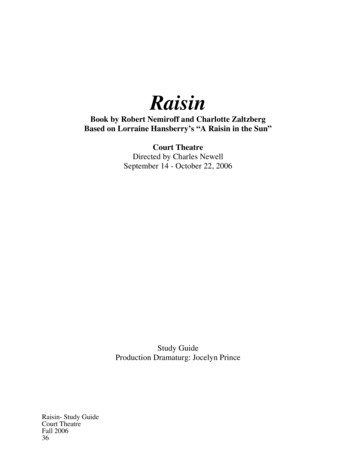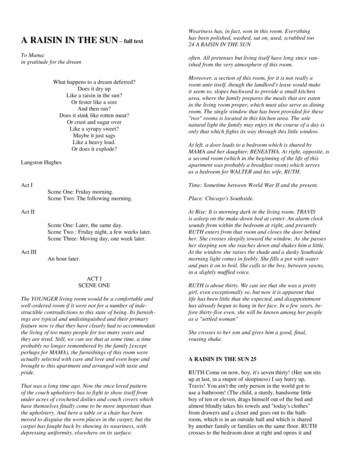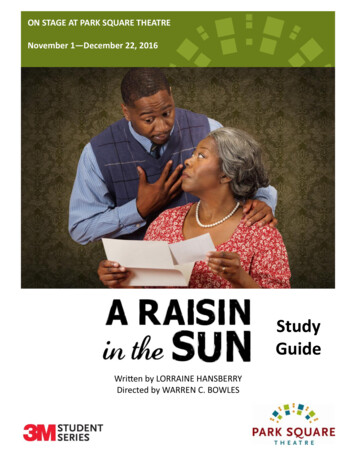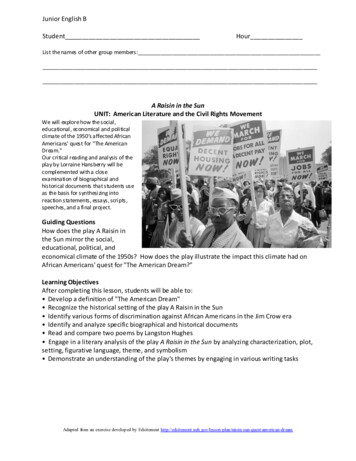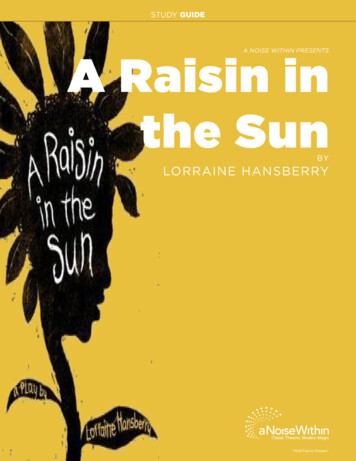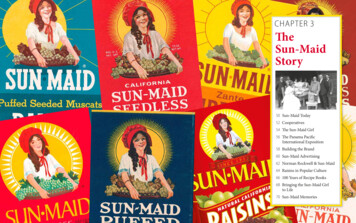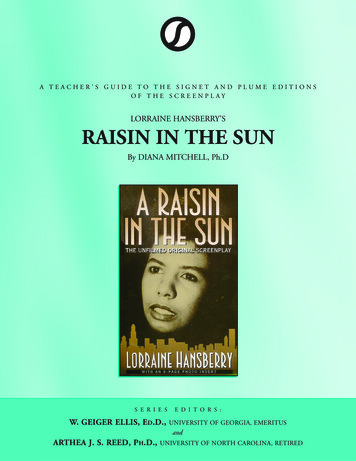
Transcription
sA TEACHER’S GUIDE TO THE SIGNET AND PLUME EDITIONSOF THE SCREENPL AYLORRAINE HANSBERRY’SRAISIN IN THE SUNBy DIANA MITCHELL, Ph.DS E R I E SW. GEIGER ELLIS, ED.D.,E D I T O R S :UNIVERSITY OF GEORGIA, EMERITUSandARTHEA J. S. REED, PH.D.,UNIVERSITY OF NORTH CAROLINA, RETIRED
A Teacher’s Guide to Lorraine Hansberry’s A Raisin in the Sun2INTRODUCTIONThe certainty that the ideals of “life, liberty, and the pursuit of happiness” can become reality for anyone willing to workfor them is what we call the American dream. For many, the dream does come true. For many it does not.Lorraine Hansberry knew about disappointment, false hope, and despair. For many of her African-American ancestorswho had come north for a better life only to find exploitation and frustration, the dream had become a nightmare. Incontemporary terms, she chronicles their nightmare in A Raisin in the Sun, an epic story of the Younger family strugglingto realize the dream by escaping ghetto life. Hansberry’s screenplay not only tells the story of the Youngers but reveals theplight of all who have failed dreams.Her cosmic vision gives Raisin its power. For high school juniors who often study U.S. history concurrently withAmerican literature, this previously unpublished version of the screenplay allows students to read an engrossing Americanplay, while they experience a culture that either mirrors their own lives or provides a window into a world of people whoare more similar to them than they are different from them.Raisin is an excellent choice for literature, drama, history, and film classes. There is plenty of action, salty dialogue, and acast of dynamic characters to captivate even the most “video-ed out” teenager. Rebellion against parents and frustrationwith a lifestyle that brings little gratification are conditions most young people endure. However, beneath the cynicalveneer of the adolescent, beats the heart of an idealist who wants to believe in dreams that do come true. ThroughHansberry’s careful craftsmanship, the universal themes of the importance of dreams and the frustration of dreamsdeferred, the strength of family, the importance of not selling out, the problems of conflicting expectations, the belief thatlove and trust will win over deceit and selfishness, and the dangers of prejudice and stereotyping are as powerful today asthey were nearly four decades ago when she wrote the play. Today’s students, often from fractured families, need as muchexposure as possible to values taught within a traditional family unit, and Raisin delivers without preaching.Another reason for using Raisin is its historical value. The play is a provocative reflection of racial attitudes of the 1950sand of today. Prejudice assumes many forms, and Hansberry’s characters and the screenplay’s visuals bring this theme tolife in a way no textbook could.This teacher’s guide contains an annotated list of characters, a brief synopsis of the screenplay, and teaching suggestionsto be used before, during, and after reading the play. There are activities, discussion questions, and topics for writingassignments. All suggestions are applicable for students of average academic ability. Those recommended for the advancedstudent are denoted with an asterisk (*).OVERVIEWDRAMATIS PERSONAELena Youngermatriarch; proud; strong-willed; deeply religious; believes in the strength of familyWalter Lee Younger Jr.ambitious; loves his family; longs to prove his manhood by owning his own businessBeneatha Youngeras ambitious as her brother with plans to be a doctor; needs to express herself, as her varying hobbies indicate;interested in her African rootsRuth Youngerloving and faithful wife and mother; wants what’s best for her family; her dream is to move into a place withmore space and sunlightTravis Youngerhis family’s pride and hope for the future; typically energetic ten year old
A Teacher’s Guide to Lorraine Hansberry’s A Raisin in the Sun3Asagaifellow student; loves Beneatha; a “modern” African, committed to preserving the cultural heritage of his NigerianpeopleGeorge Murchisonmodern African American who believes that success lies in imitating whites; scorned by Walter Lee whoconsiders him a phonySYNOPSIS OF THE SCREENPLAYThe screenplay is presented as a continuous unit of action rather than divided into dramatic acts. Punctuated only byHansberry’s clear instructions for camera shots and angles and her precise notes for the actors, it reads with the sweepingmotion of a film. The camera is in many ways the film’s most important voice. Through Hansberry’s camera instructions,readers learn more about her characters than from their words alone.The opening scene, Hansberry tells us, is a pan shot of Chicago’s Southside during the 1950s (although it could as wellbe the 1990s). Exterior and interior images show that we are in a ghetto, and this is how people live here. Moreimportantly this is a ghetto of African-Americans who have few choices in a white society. Over the panning shots issuperimposed Langston Hughes’ poem “Dreams,” providing the inspiration for the title, “What happens to a dreamdeferred? Does it dry up like a raisin in the sun?”The next series of shots introduces the family whose dreams provide the basis for the play. Lena Younger, the familymatriarch, is expecting a 10,000 life insurance check from the estate of her late husband, Walter Lee. With it, she isplanning to retire from her maid’s job for a white family. Her son, Walter Lee, Junior, wants to use the money to buy aliquor store. His wife, Ruth, also a domestic in a white household, hopes to move to a larger apartment. Beneatha, Lena’sdaughter, dreams of going to medical school.When the check arrives, the tensions within the family build. Walter Lee feels he is entitled to it as the rightful head ofthe family. Ruth and Beneatha counter that it is Lena’s money, and she should decide how it is to be spent. Because Lenarealizes that the family’s survival depends on their escape from the apartment, she makes a down payment on a “nicehouse” in Clybourne Park, an all-white residential neighborhood, without consulting anyone. The family’s reactions rangefrom Walter Lee’s disbelief and disappointment to Ruth’s joy.The plans for the move exacerbate the tensions. Feeling his manhood threatened by his mother’s authority, Walter escapesto bars. When he does not return home for several days, Lena finally acknowledges his desperate need and finds him inhis favorite lounge. Opening her purse, she entrusts him with the rest of the money, part of which is to be used forBeneatha’s tuition, the rest for his liquor store.The residents of all-white Clybourne Park have learned of their new neighbors and send an emissary to meet with theYoungers to explain the “rules.” Mr. Lindner, the representative, carefully disguises his racist attitudes beneath neutralterms (“not rich and fancy people; just hardworking, honest people who don’t really have much but those little homes anda dream of the kind of community they want to raise their children in” 164). Beneatha immediately realizes he isproposing to buy them out (“Thirty pieces and not a coin less,” 165). He makes the Youngers a generous offer that WalterLee refuses. His family has a right to a new life, and they will move to Clybourne Park.The tension reaches a climax on moving day when Walter Lee receives the worst possible news; Lena’s money never madeit to the bank. He had given it to Willy Harris, a “trusted” business partner. However, Willy took the money and ranleaving no forwarding address.Overwhelmed, the family members react in different ways. Beneatha is furious and totally repudiates her relationship withWalter. Lena starts to unpack saying they can no longer move. Ruth refuses to give in believing that with hard work theycan make the house payments. In a desperate act to set matters right, Walter Lee sends for Mr. Lindner whose offer couldreplace the money he has given away. No one supports his decision feeling contempt for his willingness to sell their dreamsso cheaply. In the final scenes, Walter Lee has an epiphany recognizing not only who he is but his place within his familyand race. As he starts to tell Mr. Lindner they will accept the offer, he hears what he is about to say and, instead, refusesit. The moving men are told to continue, and the family departs for what everyone hopes will be a new and better life.
A Teacher’s Guide to Lorraine Hansberry’s A Raisin in the Sun4A BRIEF BIOGRAPHY OF THE AUTHORLorraine Hansberry was born in Chicago on May 19, 1930, and died of cancer at the age of thirty-four. A Raisin in theSun, her first play, was also the first Broadway production written by an African-American woman and the first by anAfrican American to win the New York Drama Critics Circle Award (1959). It was subsequently made into a film (1961)for which this screenplay was written by Hansberry but only partially used by David Susskind, the film’s director andproducer, a musical (1973), and a PBS television production for American Playhouse (1989). Although deeply committedto the African-American human rights struggle, Hansberry was not a militant writer. Her only other completed play isThe Sign in Sidney Brustein’s Window (1964). Another drama, Les Blancs (1970) was adapted after her death by herhusband and Broadway producer Robert Nemiroff. He also compiled her writings in To be Young, Gifted and Black:Lorraine Hansberry in Her Own Words (1969), also presented as an off-Broadway drama in 1969.BEFORE READINGTEACHING A RAISIN IN THE SUNIt is helpful to introduce students to a work of literature prior to reading it. This is particularly important when the workmay be difficult for some students to read or may present themes or ideas that are complex and/or controversial. Althoughthe screenplay of Raisin in the Sun is simple in terms of vocabulary and sentence structure, many students will beunfamiliar with how to read a screenplay or even a play. Therefore, it is important to help them understand how readinga screenplay differs from reading a novel. In addition, the themes of Raisin are mature and may need some introductionso that students can appreciate the power of Hansberry’s deceptively simple work.HOW TO READ A SCREENPLAYHelp students understand the differences between a play and a screenplay/film. In the screenplay, Hansberry’s camerainstructions are very clear. Most students will have no difficulty in picking up on her cues as they read. MargaretWilkerson’s introduction (xxvix-xliv) explains them within the context of the entire screenplay. Teachers might find it helpfulto read this introduction before teaching the screenplay. The teacher cannot stress enough the importance of the camera’s rolein this screenplay. It provides the most important voice, albeit a visual one. Hansberry’s screenplay represents her beliefthat images, characters, and dialogue work as one entity. Her “cinematic vision” (Wilkerson, xxx) should be introducedto the students since it is easy to get caught up in her words and lose the power of these complementary images.As a class go to a stage play being presented in your school, another school, college, or the community. If this is notpossible, brainstorm stage plays the students have previously seen.Either orally or in writing have students respond to these questions: What did you like about the play? What did youdislike about the play? How was it different from watching a movie? How was it different from watching a video ortelevision program at home?(NOTE: If you cannot arrange to see a stage play and some or all of the students have never seen one, substitutea church pageant, rock concert, or any unfilmed event involving a stage, performers, and audience.)Using one or two plays students have seen in common or one they have previously read in common, review the basics ofdramatic structure. Ask students to respond either in writing or in small group discussion to the following: What is meant by exposition, rising action, climax, falling action, resolution? Give examples from a play you haveseen or read. What purpose does an act serve in a play? Why do some plays have more acts than others? Give examples from playsyou have seen or read. What are stage directions? What do the lighting and costumes add to a production? What is the purpose of an audience in a stage play? What is the purpose of the stage?
A Teacher’s Guide to Lorraine Hansberry’s A Raisin in the Sun5Either see a film or video as a class or have the students brainstorm ones they have seen. Using a film or video most ofthe students have seen in common, ask students to respond in writing or orally to the following: What does a film have that a play does not? Give some examples. What does a play have that a film does not? How does this change each medium? What is the camera’s role in a film? How is the camera used to enhance our knowledge of the plot and of characters? Of the two media (stage or film), which has the more fluid movement; why do you think so? Give some examplesfrom films you have seen.To help students learn the technical terms related to a screenplay, suggest that they develop individual or small groupglossaries of film terms: pan shots, tracking shots, traveling shots, full shot, two shot, close up, dissolve, P.O.V. (point ofview), short, long, medium shots, high angle, and montage. Have students define each term and provide an example fromfilms or videos they have seen of how each is used.Group discussion: To give students a frame of reference, discuss a familiar film or video asking the students for examplesof each type of shot.Assign two or three types of shots to several small groups. As a homework assignment ask students to watch a videoselected by their group and prepare to present examples of each type of shot to the class. They can show sections of thevideo to the class as they explain the camera technique employed.In pairs, students can prepare a notebook of visuals from either magazines or the students’ own photography illustratingseveral different types of film shots. Entries should be labeled and defined. Students should explain in writing the messagethe camera is attempting to convey and how this is accomplished.INTRODUCING THE THEMESBecause the themes of Raisin in the Sun are mature and, in some communities controversial, it may be helpful for studentsto be introduced to some of them prior to reading the screenplay. Students may first respond to the themes in a journal,then discuss their response in small groups prior to sharing them with the class.STEREOTYPING AND PREJUDICEA frank exploration of cultural/racial stereotyping should “break the ice.” Topics to which students are asked to respondshould relate to their personal experiences and observations. What is a stereotype? Give an example. Identify the ethnic/racial/religious groups of which you are a member. Discuss one way in which one or all of thesegroups are stereotyped. How does this make you feel? Give some examples of how African Americans have been stereotyped. Give some examples of stereotyping of white Americans. Using any stereotype you have been subjected to, explain the basis for this stereotype. How does this make you feel?How might this stereotype interfere with your ability to be successful or happy? Using any stereotype of an ethnic/racial/religious group of which you are not a member, explain the basis for thestereotype. How do you think this makes the members of this group feel? How might this stereotype impede a groupmember’s ability to be successful or happy? Relate a situation in which one of your stereotyped attitudes turned out to be wrong. How do you feel now? What is meant by prejudice? How do stereotypes relate to prejudice?
A Teacher’s Guide to Lorraine Hansberry’s A Raisin in the Sun6DREAMS AND DREAMS DEFERREDStudents can respond in writing and orally to the themes of the importance of dreams, what happens when dreams aredeferred or destroyed, and the American Dream.This topic is particularly good for individual or small group research. What is meant by the American Dream? Trace itsevolution from 1600 to the present. When did the phrase come into vogue? How has its meaning changed? Does it meanthe same for African Americans as for white Americans? What must happen for the dream to come true?Either read aloud or have a student who reads well read aloud Langston Hughes’ poem “Dreams.” Ask the students torespond to one or more of the following in writing or in small group discussion: What is the mood of the poem? How does the poet feel about dreams? What is the tone of the poem? If you were to hear the poet read it, what would be the sound of his voice? What simile does the poet use? What does it mean? How might it relate to what is likely to occur in the screenplayA Raisin in the Sun? Do you agree with Hughes? Give examples from personal experiences, books, television or film plots about whathappens when dreams are lost. Find other poems of songs about dreams. How do they differ? How are they similar? Why? Research Langston Hughes. Read other poems by Hughes. Present the result of your research to the class.* Write your own poem (song or rap) about dreams. Write an essay about your personal dreams (goals, aspirations). You might include: why the dream is important, whyyou are likely to succeed, what could cause you to fail, what you can do to avoid failure.*THE CONFLICT BETWEEN EXPECTATIONSThis theme is a part of every student’s life and they can respond to it individuality or in small groups. What is expected of you at home? At school (by adults)? Are these expectations realistic? How do your expectationsof yourself differ from adults’ expectations of you? What do your peers (friends, members of your group or gang, others who are not friends or members of your group)expect from you? Do you share these expectations? How do they differ? What problems occur if your expectations and others’ expectations of you differ? Give a specific example fromexperience or the experience of someone you know. If your expectations differ from those others have of you, how can you resolve this? Where does your personal loyaltybelong?A scene related to this theme that should capture students’ interest is the confrontation between Walter Lee, Ruth, andLena over the spending of the insurance check. Ask three students who read aloud well to present this scene (102-108) tothe class. Or, present this scene from the film. Following the reading/viewing have students respond in writing or orallyto the following: What is your opinion of each character? What conflicts are taking place? Why? How could they be resolved? Why are the expectations of each character so different?
A Teacher’s Guide to Lorraine Hansberry’s A Raisin in the Sun7THE STRENGTH OF FAMILYMost students are a part of a family of one kind or another. This is an opportunity for them to explore their own feelingsabout family. Write about or discuss what family means to you. You might include: different types of families, what type of familyyou are a part of, why your family is important to you, positive or negative aspects to being a member of a family,what you have learned by being a part of your family, loyalty or lack of loyalty within your family. Imagine what it would be like to not be part of a family. Write a story or poem about how this makes you feel.USE OF LANGUAGELorraine Hansberry uses language to help develop her characters. As in Shakespearean drama, the language in A Raisin inthe Sun reflects the social and economic status of the characters in the play. It is helpful for students to understand thatthe language of the characters helps viewers understand who they are.Point out to the students some examples of how language helps us know Hansberry’s characters.RUTH: What you mean, out? He ain’t hardly had a chance to be in there good yet.(9)WALTER: Un-hunh. That’s what you mad about, ain’t it? The things I got to talk about with my friends justcouldn’t be important in you mind, could they! (11)TRAVIS: Teacher says we got to do something ‘bout teaching colored kids ‘bout their history. So they set up afund to buy special books that tell all about the things the poor Negroes did. (13-14)LENA: Near ‘bout. ‘Cept-’cept, Lord have mercy, when the war, praise God, come along a few years back. Thatsure changed things for a while. My husband had been a porter on the railroads all his life, and just as soon aswe heard they had started taking colored in the de-fense plants and all, me and him both marched right on overand took the classes they was giving in the welding and all. (41)ASAGAI: Because I suppose all Africans are revolutionaries today, even those who don’t know that they are. Itis the times. In order to survive we must be against most of what is. (50)BENEATHA: Mama, you don’t understand. It’s all a matter of ideas, and God is just one idea I don’t acept. It’snot important. I an not going out and commit crimes or be immoral because I don’t believe in God. I don’t eventhink about it. It’s just that I get so tired of Him getting credit for all the things the human race achieves throughits own stubborn effort. There simply is no God! There is only Man, and it’s he who makes miracles! (76)LENA: Now-you say after me: “In my mother’s house there is still God.” (Silence.) “In my mother’s house thereis still God.” (77)LINDNER: Well-it’s what you might call a sort of welcoming committee, I guess. I mean they-we-I’m thechairman of the committee-go around and see the new people who move into the neighborhood and sort of givethem the lowdown on the way we do things out in Clybourne Park.And we also have the category of what theassociation calls-(he looks eleswhere)-uh-special community problems. (161)In small groups, have the students respond to or complete the following. What do each of these quotes tell you about each person’s character, beliefs, fears, frustrations? What emotions areyou likely to hear in the person’s voice? Prepare one quote to present to the class as you believe the character would deliver it to the audience. Try it usingdifferent tones of voice. Does the meaning change? If the quote is in non-standard English, rewrite it in standard English. Now, answer the same questions about eachrewritten quote. Prepare to deliver the quote you rewrote to the class as originally written and in standard English. Ask the class: Whatdoes each version suggest about the character?
A Teacher’s Guide to Lorraine Hansberry’s A Raisin in the Sun8WHILE READINGTeachers will want to select some activities from the many suggestions offered.FILM TECHNIQUESIt is helpful to analyze Hansberry’s camera instructions closely as you read. Ask: What silent messages do they convey?The following camera shots represent highlights from the screenplay; students should be encouraged to find others: Pan shots of Chicago’s Southside (3). Ask: Who lives here? Why do they live here? Why does Hansberry think theseshots are important? Pan shot within the Younger apartment (4-7). Ask: How does this shot introduce us to the family and the likelyaction of the film? Closeups of Lena’s hands (31), Walter’s hands (43), their employers’ hand (39,45). Ask: What do hands reveal aboutcharacter and lifestyle? Why does Hansberry put so much emphasis on hands? Exterior shots of the neighborhoods Lena and Walter must pass through enroute home to their apartment (57). Ask:What are these neighborhoods like? Why is Hansberry emphasizing these shots? Interior shots of Beneatha’s relatively sheltered college routine (47). Ask: What do these shots tell us about Beneatha?Why is this knowledge important? Exterior high/wide angle shot of Lena’s detour to the open market (56). Ask: What point is Hansberry making in this shot? Interior/wide angle shots of Walter drinking with Willy and Bobo in the type of lounge for which they hope toprovide liquor (81). Ask: What does this shot reveal about Walter and his dreams? Montage of Walter drinking alone, driving around Chicago, wandering aimlessly around the Loop, stopping underthe Negro Soldier’s monument, listening to the street preacher harangue (128-132). Ask: What do these shots tell usabout Walter? About his life? What do they reveal about the plot of the screenplay? The juxtaposition of shots of Asagai, the new African, with shots of Walter (132-133). Ask: What do these shotsreveal about these two characters? Why is the juxtaposition important? Shots of the Youngers’ visit to Clybourne Park including the neighbors’ reactions (149-151). What do these shotsreveal about what is to occur in the plot? What do we learn about the family from these shots? The final shot of the apartment, window, plant, and Walter Lee and Lena (206). What does this shot reveal aboutthe characters and about their dreams?Because this is a screenplay that is meant to be acted and seen, it is best when read orally by the students. To help themintegrate the words with the images suggested by Hansberry’s camera instructions, stop their reading periodically and ask: What does this shot convey about the character (or setting)? For example: The QUICK FLASH of Lena’s annoyedface as she is being sold inferior apples (52). Why is this type of shot specified rather than another? For example: Later in the scene, Hansberry’s directions changeto a CLOSE SHOT of Lena’s outraged face (53). How do the words spoken (or image seen) represent this character’s point of view? For example: Mrs. Holiday, Lena’s employer,is looking around the kitchen while Lena is speaking to her from the sink where she is washing a child’s toys (39). Why is the camera on “this” character (scene) when another character is speaking? For example: Walter receiving hischauffeuring assignment for the morning (45).As students become familiar with the interrelationships of camera shots, dialogue, and action, informal writing responsesmight be assigned. Offer your own camera directions as if you were writing the screen play, defending why you altered Hansberry’s directions.
A Teacher’s Guide to Lorraine Hansberry’s A Raisin in the Sun9UNDERSTANDING IRONYThe voice heard in Raisin in the Sun is ironic. Students can be helped to see the irony in the screenplay by responding toit orally or in writing. Examples of irony can be suggested as they read, and they can then be encouraged to keep theirown list of the play’s ironies. African Americans came north to find the economic, social, and educational equality denied them in the south only todiscover the same (133-134). Examples of this can be seen throughout the screenplay: the inadequate housing in theghettos (4-5), the lack of materials in Travis’ school (13), and price gouging in an African-American neighborhood (56). The irony of having to pay more for homes and food (56) in poor neighborhoods than in rich neighborhoods. Lena’s labors ease those of the Holiday family although Lena receives no leisure time or holidays (31-42). Mr. Lindnerextols the values of hard work and neighborhood pride as he offers the Youngers “easy” money to stay away fromClybourne Park (162-167).GETTING TO KNOW THE CHARACTERSAssign each character to partners, even if several partners have the same character. One student can chart a list of physicalcharacteristics mentioned in the screenplay, and the other can trace the personality/character traits. Cite references fromthe screenplay.At intervals during the reading all students charting the same character should meet in a small group to discuss thecharacter. Each group is to reach a consensus on how to present a definitive character portrait or sketch to the class.Appoint a recorder to keep notes. The following might be included in the portrait: a photograph, magazine illustration,or original art work to show the physical attributes of the character. Dramatic readings from the screenplay designed toreveal the character’s personality. A video presentation of the character, incorporating some of Hansberry’s characterrevealing camera shots.In writing or in small groups, trace the development/resolution of conflicts between/among the characters to be sharedlater with the whole class. Examine/ discuss the following: Walter Lee and Ruth. What are their expectations of each other? Walter Lee and Beneatha. Are they sensitive to each other’s needs, or have they become locked into the “siblingrivalry” syndrome? Walter Lee and Lena. Is she unconsciously emasculating him? Is he behaving more like a son than a husband andfather? What cultural traditions affect their relationship? Lena and Ruth. Is Lena trying to undermine Ruth’s maternal authority by commenting on what Travis eats, how hedresses, and her excusing his lapses as “he’s just a little boy” [31]? Beneatha and Asagai. What cultural differences cause tension in their relationship? How does he prove he really caresfor her?Reenact the scenes in which dramatic tension is greatest. The teacher or a student director should position the actors andstress the most appropriate voice inflections to convey what is happening between/among them. Students can eithermemorize* or paraphrase their lines. Scenes that lend themselves to reenactment are: Walter, Ruth, Beneatha. The argument over the spending of the insurance money (20-29). Lena, Ruth, Beneatha. Beneatha’s refuting the existence of God’s will infuriates her mother (70-77). Walter, Lena, Ruth. Lena reemphasizes her objection to the liquor store; Ruth admits she is planning an abortion(102-110). The Younger family. Lena announces that she has made the down payment on the house in Clybourne Park (121127). Lena and Walter. Lena finally acknowledges Walter’s need and entrusts him with the rest of the money (138-142).
A Teacher’s Guide to Lorraine Hansberry’s A Raisin in the Sun10 Beneatha and Asagai. Asagai reveals his compassionate understanding of human nature and his wisdom; his proposalto Beneatha (180-190). The Young
A Teacher’s Guide to Lorraine Hansberry’s A Raisin in the Sun 3. A BRIEF BIOGRAPHY OF THE AUTHOR Lorraine Hansberry was born in Chicago on May 19, 1930, and


